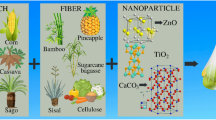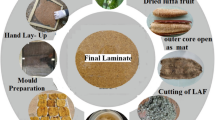Abstract
The preparation of composites by thermoforming of intermingled fibre slivers is an efficient method to receive high performance and lightweight materials. Cellulosic fibres have benefits like low density and sustainability but the sorption of water due to the high hydrophilicity of the cellulose requires attention. The swelling of the wet fibres changes the fibre-matrix adhesion and as a consequence, the mechanical strength of the composite is influenced negatively. In this study, the thermoplastic polypropylene was combined with lyocell fibres as reinforcement. Moisture sorption isotherms of cellulose/polypropylene composites were recorded as function of relative humidity. Additionally, the specific surface area was analysed by the Brunauer–Emmett–Teller model. It has been found, that the moisture sorption is influenced by the polypropylene (PP) ratio in the composites. At 60% relative humidity the moisture uptake of the lyocell fibres was reduced from 10.8 to 5.8% for lyocell embedded in a composite with 50% polypropylene. Besides the hysteresis between moisture sorption/desorption cycles was found to be proportional to the increased content of PP. The “Parallel Exponential Kinetics” (PEK) model was used to analyse the kinetics of moisture sorption of these composites in more detail. With the help of the PEK model the sorption/desorption kinetics were described by a fast and slow moisture sorption/desorption process. The capacity for rapid moisture sorption is reduced by the formation of PP layers on the lyocell surface. The share of slow moisture sorption increased with increasing PP content in the composite. The results support understanding of the interaction of water with cellulose containing composites.










Similar content being viewed by others
References
Brunauer S, Emmett PH, Teller E (1938) Adsorption of gases in multimolecular layers. J Am Chem Soc 60:309–319. doi:10.1021/ja01269a023
Froix MF, Nelson R (1975) The interaction of water with cellulose from nuclear magnetic resonance relaxation times. Macromolecules 8:726–730. doi:10.1021/ma60048a011
Gray DG (2008) Transcrystallization of polypropylene at cellulose nanocrystal surfaces. Cellulose 15:297–301. doi:10.1007/s10570-007-9176-2
Hatakeyama T, Nakamura K, Hatakeyama H (2000) Vaporization of bound water associated with cellulose fibres. Thermochim Acta 352:233–239. doi:10.1016/S0040-6031(99)00471-2
Hofstetter K, Hinterstoisser B, Salmén L (2006) Moisture uptake in native cellulose: the roles of different hydrogen bonds: a dynamic FT-IR study using Deuterium exchange. Cellulose 13:131–145. doi:10.1007/s10570-006-9055-2
Joly C, Gauthier R, Chabert B (1996) Physical chemistry of the interface in polypropylene/cellulose-fibre composites. Compos Sci Technol 56:761–765. doi:10.1016/0266-3538(96)00018-8
Khan F, Pilpel N (1987) An investigation of moisture sorption in microcrystalline cellulose using sorption isotherms and dielectric response. Powder Technol 50:237–241. doi:10.1016/0032-5910(87)80069-4
Kohler R, Dück R, Ausperger B et al (2003) A numeric model for the kinetics of water vapor sorption on cellulosic reinforcement fibers. Compos Interfaces 10:255–276. doi:10.1163/156855403765826900
Kohler R, Alex R, Brielmann R, Ausperger B (2006) A new kinetic model for water sorption isotherms of cellulosic materials. Macromol Symp 244:89–96. doi:10.1002/masy.200651208
Luukkonen P, Maloney T, Rantanen J, Paulapuro H, Yliruusi J (2001) Microcrystalline cellulose-water interaction: a novel approach using thermoporosimetry. Pharmaceut Res 11:1562–1569. doi:10.1023/A:1013030414555
Matthews JF, Skopec CE, Mason PE et al (2006) Computer simulation studies of microcrystalline cellulose Iβ. Carbohyd Res 341:138–152. doi:10.1016/j.carres.2005.09.028
Mihranyan A, Llagostera AP, Karmhag R et al (2004) Moisture sorption by cellulose powders of varying crystallinity. Int J Pharm 269:433–442. doi:10.1016/j.ijpharm.2003.09.030
Nakamura K, Hatakeyama T, Hatakeyama H (1981) Studies on bound water of cellulose by differential scanning calorimetry. Text Res J 51:607–613. doi:10.1177/004051758105100909
Okubayashi S, Griesser UJ, Bechtold T (2004) A kinetic study of moisture sorption and desorption on lyocell fibers. Carbohyd Polym 58:293–299. doi:10.1016/j.carbpol.2004.07.004
Okubayashi S, Griesser UJ, Bechtold T (2005a) Water accessibilities of man-made cellulosic fibers: effects of fiber characteristics. Cellulose 12:403–410. doi:10.1007/s10570-005-2179-y
Okubayashi S, Griesser UJ, Bechtold T (2005b) Moisture sorption/desorption behavior of various manmade cellulosic fibers. J Appl Polym Sci 97:1621–1625. doi:10.1002/app.21871
Quan H, Li Z, Yang M, Huang R (2005) On transcrystallinity in semi-crystalline polymer composites. Compos Sci Technol 65:999–1021. doi:10.1016/j.compscitech.2004.11.015
Quillin DT, Caulfield DF, Koutsky JA (1993) Crystallinity in the polypropylene/cellulose system. I. Nucleation and crystalline morphology. J Appl Polym Sci 50:1187–1194. doi:10.1002/app.1993.070500709
Shanks RA, Hodzic A, Wong S (2004) Thermoplastic biopolyester natural fibre composites. J Appl Polym Sci 91:2114–2121. doi:10.1002/app.13289
Sheppard SE, Newsome PT (1934) The sorption of water by cellulose. Ind Eng Chem 26:284–290. doi:10.1021/ie50291a013
Siroka B, Noisternig M, Griesser UJ, Bechtold T (2008) Characterization of cellulosic fibers and fabrics by sorption/desorption. Carbohyd Res 343:2194–2199. doi:10.1016/j.carres.2008.01.037
Siroka B, Manian AP, Noisternig MF et al (2012) Wash-dry cycle induced changes in low-ordered parts of regenerated cellulosic fibers. J Appl Polym Sci 126:396–407. doi:10.1002/app.36894
Wambua P, Ivens J, Verpoest I (2003) Natural fibres: can they replace glass in fibre reinforced plastics? Compos Sci Technol 63:1259–1264. doi:10.1016/S0266-3538(03)00096-4
Funding
This project has received financial support from the Vorarlberger Landesregierung, Austria. Authors thank Schoeller Hard for preparation and providing of intermingled sliver samples.
Author information
Authors and Affiliations
Corresponding author
Ethics declarations
Conflict of interest
The authors declared no potential conflicts of interests with respect to the research, authorship, and/or publication of this article.
Additional information
University of Innsbruck is a member of EPNOE - European Polysaccharide Network of Excellence, www.epnoe.eu.
Rights and permissions
About this article
Cite this article
Cordin, M., Griesser, U.J. & Bechtold, T. Analysis of moisture sorption in lyocell-polypropylene composites. Cellulose 24, 1837–1847 (2017). https://doi.org/10.1007/s10570-017-1227-8
Received:
Accepted:
Published:
Issue Date:
DOI: https://doi.org/10.1007/s10570-017-1227-8




